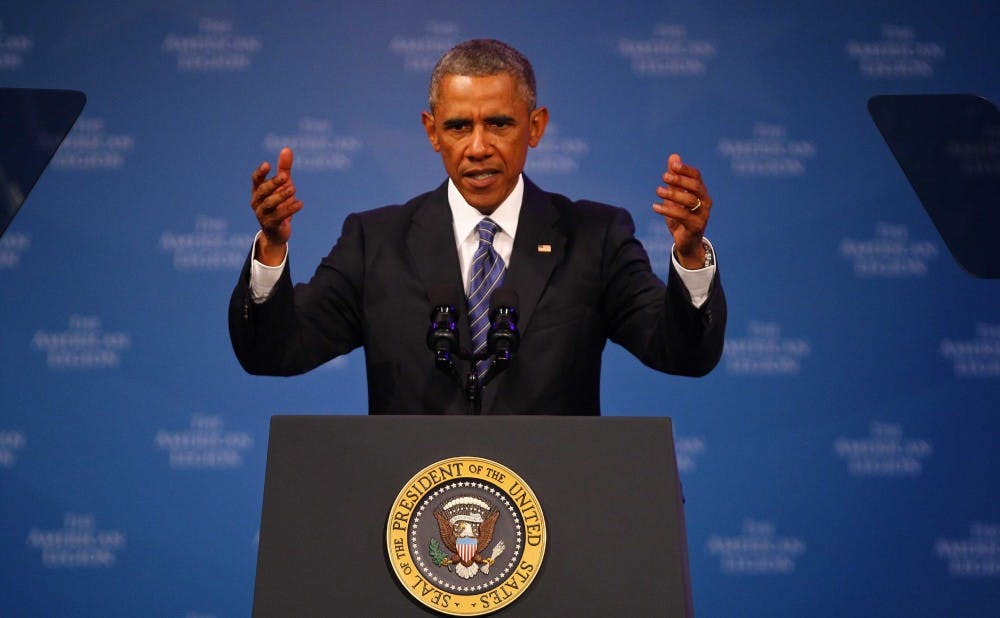After years of flat budgets and funding cuts, Duke researchers are looking ahead to possible increases in the National Institutes of Health’s budget for 2016.
President Barack Obama has requested a $1 billion increase in the NIH’s budget for the fiscal year 2016, which will translate to a 3.3 percent increase in funding. This comes after the 2013 budget sequestration slashed the NIH’s funding by 5 percent, with little to no increase in the years since.
“In general, the NIH budget has been in a period of stagnation,” said Michael Schoenfeld, vice president of public affairs and government relations. “The president’s budget request for 2016 is larger than we’ve seen in years. Obviously there’s a long way to go, but Duke, the other research universities and our advocates in Washington will be making a very strong case for why it’s important to the entire country.”
Obama’s request for a 3.3 percent increase in 2016 comes after the budget passed by Congress for 2015 kept NIH funding flat, continuing cuts in many research programs.
Some programs, however, did see small increases in funding. Areas that received more money in 2015 included Alzheimer’s research, Obama’s BRAIN initiative and a new pediatric research program. In total, $150 million added to these programs, which is 0.5 percent more than the programs received last year. The budget also allocated a separate $238 million fund for Ebola research and vaccine development.
Barton Haynes, director of the Duke Human Vaccine Institute and the Center for HIV/AIDS Vaccine Immunology, received a grant of nearly $30 million from the NIH last year in pursuit of an experimental HIV vaccine.
“I have lots of grant money because of a competition that started to change the HIV vaccine field,” Haynes said of the grant, first awarded in 2005. “My funding comes from a very special need. The government decided to solve a particular problem, which is why I’m in this unique situation.”
The request for the $1 billion increase for 2016 will also be targeting Alzheimer’s and brain research, as well as funding research into antimicrobial resistance and Obama's newly announced Precision Medicine Initiative.
Although the new NIH budgets have stopped making cuts to program funding, researchers still find themselves competing more for grants.
“It is still a challenging time for biomedical researchers, because there are far more worthy projects and proposals than there is funding to support them,” Schoenfeld said. “Research activities have been growing, but funding available from the NIH has not been growing at the same rate.”
One of the consequences of the overall stagnation in research funding over the past several years has been the pressure put on new scientists entering the field, Schoenfeld said.
“It has a ripple effect by discouraging people from going into basic research,” he explained. “How do you measure the impact of something that doesn’t get discovered? It’s a liability not only for this institution but for society.”
The average age at which principal investigators receive their first research grant from the NIH has been increasing for decades. It currently is 42 years of age, a number that the NIH is looking to reduce in 2015, according to the spending agreement reached by Congress. While Haynes currently receives the highest amount of NIH funding of anyone at Duke, most faculty are trying to get small to mid-sized grants in a time of what he called research austerity.
“Our people are competing relatively well, but we’re trying to get [more] support for our young people,” Haynes said. “My hope would be that there’s increased funding for young scientists to get individual grants, to allow more fundamental and basic research to continue.”
Steve Harward, a sixth-year graduate student in neurobiology, has a three-year fellowship through the NIH. Though finding funding can pose issues, he said, Duke works to provide graduate students with the knowledge required to work the system and get the necessary money.
“You hear lots of concerns about the funding situation—these are true, but I would still say that overall, the people here at Duke have been extremely creative and have gone beyond the NIH to find money," Harward said. "Especially if it’s one of those ideas you’re really passionate about.”
Haynes also emphasized the importance of funding student research, which he said contributed to the overall environment at Duke.
“Basic research funds, primarily driven by NIH, make a wonderful college atmosphere here where students can contribute as much as faculty, so it’s very important for society and our educational environment,” Haynes said. “We’re just hoping and waiting to see if the president’s new budget will fare well.”
Schoenfeld said that the University will continue to push for increased research funding. Duke’s federal relations team has been working to support the proposed 2016 budget increases. It also works with faculty on campus and with Congress to articulate the importance of research and research funding, Schoenfeld explained.
“We educate and inform other advocates who we hope will make the case for basic science research,” he said. “The entire country has a stake in the continuation of science and research.”
Get The Chronicle straight to your inbox
Signup for our weekly newsletter. Cancel at any time.

